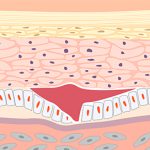In skin not affected by DEB, type VII collagen protein helps form anchoring fibrils.
Anchoring fibrils help hold, or anchor, the inner (dermis) and outer (epidermis) skin layers together.
- Epidermis
- Dermis
- Anchoring fibrils (collagen VII)
EB is not one disorder. It is a group of genetic blistering disorders that share symptoms of fragile skin, which means the skin easily tears and blisters.
There are 3 major types* of EB: dystrophic epidermolysis bullosa (DEB), epidermolysis bullosa simplex (EBS), and junctional epidermolysis bullosa (JEB).
Each type of EB has a unique genetic cause, affecting the body’s ability to make different proteins and causing separation in the layers of the skin. The changes in the genes that cause EB are passed down within families. EB occurs in every racial and ethnic group and affects both genders equally.
Dystrophic epidermolysis bullosa (DEB)
Epidermolysis bullosa simplex (EBS)
Junctional epidermolysis bullosa (JEB)
Affected Genes
COL7A1
Affected Proteins
Collagen VII
Affected Skin Layer
Dermis

Affected Genes
CD151, DST, EXPH5, KLHL24, KRT5, KRT14, PLEC
Affected Proteins
BPAG1, Exophilin 5, Kelch-like protein 24, Keratin 5, Keratin 14, Plectin, Tetraspanin 24
Affected Skin Layer
Epidermis

Affected Genes
COL17A1, ITGA3, ITGA6, ITGB4, LAMA3, LAMB3, LAMC2
Affected Proteins
Collagen XVII, Integrin α3 subunit, Integrin α6ß4, Laminin-332
Affected Skin Layer
Between dermis and epidermis

Adapted from De Rosa L, Latella MC, Secone Seconetti A, et al. Cold Spring Harb Perspect Biol. 2020.
DEB and EBS are the most common types of EB—about 95% of people with EB in the United States are diagnosed with either DEB or EBS.
Even though the genetic cause of each EB type is different, all people with EB have fragile skin.
This fragile skin can lead to blisters, wounds, skin infections, and scarring. People living with EB can also have problems with their fingernails and toenails, including poor growth or thick, yellow nails.
People can have very different experiences with EB.
EB types share symptoms, but how these symptoms affect each person can be different. Even within one EB type, symptoms can vary from mild to severe. Some types of EB, like DEB, are more serious than others.
DEB is more likely to have serious risks and complications in the future.
All DEB wounds should be taken seriously. It’s possible for any DEB wound, large or small, to develop complications, such as infections or even cancer.
If you or a loved one has fragile skin that easily blisters, you can't tell by looking if it's DEB. For these reasons, accurately knowing if it's DEB is important.
*Kindler epidermolysis bullosa (KEB) is a very rare type of EB. It occurs in less than 1% of patients and affects multiple skin layers due to lack of the kindlin-1 protein.
DEB is caused by mutations in a gene called COL7A1 that result in a lack of working type VII (type 7) collagen protein.
The COL7A1 gene provides instructions for making type VII collagen protein. Type VII collagen is important because it helps hold together the outer and inner layers of the skin and the lining of some organs. Type VII collagen plays an important role in strengthening and stabilizing the skin. With DEB, this protein is either missing or there is not enough of the working protein.
In skin not affected by DEB, type VII collagen protein helps form anchoring fibrils.
Anchoring fibrils help hold, or anchor, the inner (dermis) and outer (epidermis) skin layers together.

In people with DEB, the mutation in the COL7A1 gene means the body can’t create any type VII collagen protein or enough working type VII collagen protein.
This leads to a lack of or reduced anchoring fibrils. Without anchoring fibrils, the skin layers can easily separate due to friction.

Adapted from De Rosa L, Latella MC, Secone Seconetti A, et al. Cold Spring Harb Perspect Biol. 2020.
DEB can be inherited in a dominant or recessive pattern.
People receive 2 versions of each gene, 1 from each parent. In dominant inheritance, only 1 copy of the gene with a mutation is sufficient to cause a disorder. In recessive inheritance, 2 copies are required.
With DEB, the inheritance pattern can either be dominant, called dominant dystrophic epidermolysis bullosa (DDEB), or recessive, called recessive dystrophic epidermolysis bullosa (RDEB).
Dominant dystrophic epidermolysis bullosa
DDEB occurs when a child inherits 1 copy of a dominant COL7A1 gene mutation.

Within each pregnancy:
Recessive dystrophic epidermolysis bullosa
RDEB occurs when a child inherits 2 copies of a recessive COL7A1 gene mutation.

Within each pregnancy:
In some cases, a DEB gene mutation can happen for the first time in a family member without inheriting the gene mutation from a parent. This is called a de novo mutation.
A missed DEB diagnosis can happen if doctors only look at symptoms alone
DEB can have serious risks and complications, and accurate diagnosis is the first step to address them
Getting a DEB diagnosis means you may hear new terms. Understanding these terms may help you feel more prepared for conversations with your healthcare team.
Dystrophic epidermolysis bullosa (dis-ˈtrō-fik ep-ih-dur-MOL-uh-sis buhl-LOE-sah):
A rare genetic disorder that develops when a change or mutation occurs in the gene called COL7A1. This results in the separation of the epidermis and dermis layers of skin and the lining of some organs.
Dystrophic: Refers to the disruption or degeneration of tissue. In DEB, the tissue affected is the skin and lining of some organs.
Epidermolysis: Refers to the breaking down of the skin layers.
Bullosa: Refers to blisters.
The name for a group of rare genetic disorders that cause the skin to become very fragile. Any trauma or friction to the skin can cause painful blisters.
The gene that provides instructions for making the type VII collagen protein. Collagens are a family of proteins that strengthen and support connective tissues, such as skin, bone, tendons, and ligaments, throughout the body.
Type VII collagen protein is an important component of anchoring fibrils that plays a key role in strengthening and stabilizing the skin.
Structures that connect and help adhere the epidermis layer of the skin to the dermis layer of the skin.
Refers to the relationship between 2 versions of a gene. People receive 2 versions of each gene from each parent. With a dominant inheritance pattern, the gene mutation shows its effect even if there is just one copy of the gene mutation in that pair of genes.
Refers to the relationship between 2 versions of a gene. People receive 2 versions of each gene from each parent. With a recessive inheritance pattern, there must be a mutation in both copies of the gene pair in order for the gene mutation to show its effect.
Refers to the severity of DEB. Some people will only experience localized DEB, which means the symptoms of DEB affect only a small part of their body. For most people with localized DEB, this is their fingers or toes. People with localized DEB often have fragile skin on their fingers and toes, or their fingernails or toenails will thicken and discolor.
Refers to the severity of DEB. People with intermediate DEB can experience a wide range of symptoms and severity. With intermediate DEB, skin fragility affects more places on the body, often including the elbows, knees, ankles, and the palms and backs of the hands. The risk of developing more serious complications is higher with intermediate DEB than with localized DEB.
Refers to the severity of DEB. People with severe DEB typically have RDEB and experience widespread and significant skin fragility from birth. The risk of developing serious and life-threatening complications and cancer is highest with severe DEB.
A skin biopsy is a procedure to remove cells or skin samples from the body for laboratory examination. A DEB diagnosis can be confirmed through a skin sample analysis.
A genetic test uses a blood sample or cheek swab. DNA is extracted from the sample and the laboratory checks it for mutations in a specific gene or groups of genes. A DEB diagnosis can be confirmed through a genetic analysis.
Not all blisters are the same. Could yours be DEB? Ask your doctor about a genetic test for DEB